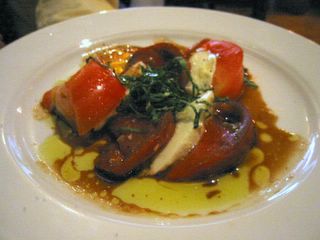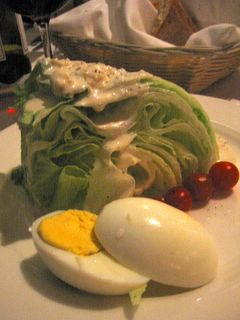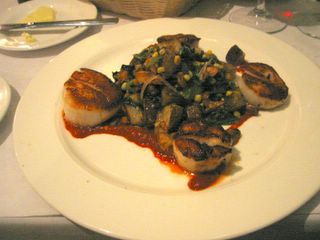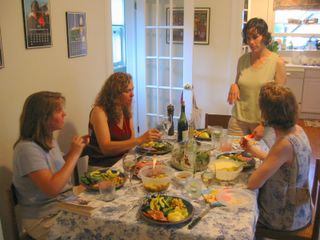A place for friends and fellow obsessors to gather
Tuesday, June 21, 2005
Advice needed: what to read and knit on vacation
Here are the details of my book predicament: I finished Shields' Unless (and recorded my impressions here). I have started last year's National Book Award Winner The News From Paraguay by Lily Tuck but so far I am underwhelmed. The library just emailed me to tell me that Shields' Larry's Party is being held for me. Annie and I planned to read this one together and I'm not sure if I should take it with me if I'm going to have spotty access to the internet while in CA--the point of a read-along is to be in regular communication with each other rather than the usual reading in isolation experience, yes?
And being the greedy gal that I am, I also have checked out of the library three of the other NBA finalists: Florida by Christine Schutt, Madeline is Sleeping by Sarah Shun-lien Bynum and Ideas of Heaven by Joan Silber. Of these, the last one tempts me the most, but again, it was going to be a read-along with Mary Jean.
It has also occurred to me that vacation may be the perfect excuse for a little splurge and I should leave all the above books at home and go buy myself a copy of Extremely Loud and Incredibly Close (Jonathan Safran Foer's newest book) which is only in hardback.
Any ideas what I should bring with me so I don't pack an entire library in my carry-on?
The second similar problem is what knitting to bring with me. I have the second sock that I'm still working on, and it is nice and portable. But right now I'm more interested in the Ribby cardigan. Last week I was reading the pattern and realized that the way it is written with the back, front panels and sleeves all knit separately would end up requiring a hell of a lot of seaming. I don't mind a little seaming, mind you, but when it comes to raglan sleeves where the seams really need to be tidy and not lumpy to look good, I start to recoil.
So I ripped out the 4 inches of the back that I had knit and am taking a bit of a plunge by rewriting the pattern to be knit without seams: the front panels and back are all being knit together on one long needle up to the sleeve insets (my birthday present to myself--since one must always protect one's Princess-self against gift disappointment by buying whatever one really wants oneself--was a set of Denise interchangeable needles. They rock.) Then I'll knit the two sleeves in the round up 'till they start shaping for the raglan and then I'll attach it all together on one huge round needle and knit the raglan decreases all together. It should work out that there are no seams and the raglan comes together (even with the separate sleeve color which will require juggling numerous attached balls of yarn) if I got all the numbers right. That's kind of a big "if"--it physically hurt my brain to do so much math. (I can't believe I used to think of myself as good at math. Talk about use it or lose it.)
I probably should have rewritten the pattern to be knit from the top down rather than the bottom up. But too late now!
So, should I take the Ribby that is a bit bigger but I'm having fun working on, or should I take the sock which is very portable and easy?
Sunday, June 19, 2005
Another gluttony belt needed...
I'll cut to the chase--we had a fantastic dinner. If you want to look at the current menu, it is posted on their site. I took photos, of course (without flash, forgive the grainy quality).
We started with the Farmer's charcuterie plate--Polcyn is known for his house-cured charcuterie and for a good reason.

Clockwise from top: a soppresatta-style salami, liver pate with pickled ramps and a ham-studded potato salad, crouton with lardo, a smoked dry salami, and Westphalian ham with baby basil leaves.

I call it, Bliss in a Bowl



Pan Roasted Breast of Indiana Duck

Caramelized Scallops
With dinner we polished off a nice pinot noir and the wine list was good and the prices were not outrageous. I had steeled myself to be paying through the nose and was relieved to find a few acceptable offerings in the $27-35 range.
We won't be able to afford to go back whenever we have a whim for a good meal, but we do now have a favorite special occasion restaurant. Also, on Tuesdays, the chef leads a special 5 wines with 5 appetizers tasting for $20 which could be a good way to have a little week-night treat. It would be a lot of fun to meet up there with some friends for the tasting and afterwards go for a walk or canoe paddle at the nearby Kensington Metro Park.
Friday, June 17, 2005
Let the Foraging Begin!
Foraging is something I love--it fulfills both the food obsessed part of my personality and the tightwad principles I was raised with. Yesterday, even the 2 year old was walking faster than I was because I kept dropping down to pick more berries. In the end, it started getting dark (and yes, kids went to bed way after their bedtime) and I had to leave many of the berries unpicked. To me this felt like walking past gold coins that were scattered by the edge of the path and ignoring them.
So I'm going back. This time with a bucket. Will I tell you where to find this bounty? The forager in me is highly secretive of such finds, but I promise, after I get one more crack at them I'll share...
Thursday, June 16, 2005
Tea time
Tea was pretty good too with scones, jam, finger sandwiches, tea cookies and little pastries. And a big pot of tea for each of us (even the kids--they had an herbal berry tea and had fun putting lots of sugar cubes in with the little silver tongs). My only gripe is what they tried to pass off as Devonshire Cream--it tasted like Cream Cheese frosting, sweet and tangy. Real Devonshire clotted cream is a sticky, unsweetened ooze with soft-butter consistency. It has a fat content of about 55% and often is thick enough to stand a (small) spoon up in it. Normal (single) cream is about 35% fat, whipping (heavy) cream is about 45%. And it is expensive at about $5-6 for a 5 oz jar.
Some cheap tea shops in England advertise cream teas and serve them with unsweetened whipped cream which I'd say is a preferable second to this frosting stuff they gave us. Mind you, Ian loved the whole tea, cream cheese goo and all. And I was thrilled that he ate one and a half scones with goo and jam and didn't cast his usual suspicious gaze over the whole enterprise.

While Ian sampled Napoleon pastries...

Fiona filled her shoes with rocks....
Granny Jan had a wonderful time, loved hanging out with the critters and wasn't bummed by the lack of real clotted cream. But I feel the need to provide an authentic cream tea for my British mum, so next week I'll track down some of the real stuff (Big 10 probably has it), make her some scones and serve them with gloppy strawberry preserves (Trader Joe's has a good version with big chunks of fruit), and a big pot of tea.
Here is my scone recipe, straight from my British mum:
English Scones
1 and 3/4 C flour
1 T baking powder
1/2 t salt
1/4 C sugar
1/4 C unsalted butter
1 C dried fruit (see *note for good combos below)
1/3 C milk
1 t fresh lemon or orange zest (microplane zested is best)
1 egg
Preheat oven to 425 degrees F.
Sift together flour, baking powder, salt and sugar. Cut in butter then use your fingers to flatten the little bits into flakes--don't over do it--it should not look as fine as cornmeal or your scones will be heavy. Stir in dried fruit.
Combine milk and egg, add to flour mixture and fork stir. Turn out onto floured surface and knead 5 or 6 times, just 'till you get it to hold together. Pat into a circle about 1 to 1.5 inches thick and cut into 6 wedges (like a pie). Place wedges on a parchment or silicone-lined cookie sheet. Bake for 12-15 minutes. The tops should be slightly golden.
Serve warm with jam and clotted cream or butter.
*a note on dried fruit:
Currants are the traditional dried fruit to put in scones, but you can be as creative as you like. Dice bigger stuff until it is about currant-sized.
Here are some of my favorite combos (all combine to 1 C total of dried fruit) :
diced dried pears with crystallized ginger
diced dried peaches and dried cranberries
chopped dried cherries (particularly good with orange zest)
I tried dried figs once and they were nasty...
Jerk Pork
It made for a great sandwich (the recipe I was following dictated the condiments which were not my first instinct for complementing a sandwich but turned out to be really good; an added benefit is that the sandwich would travel well and not get soggy if you were taking it on a picnic), but next time I'm just going to make the pork as an entree because I think it was even better on its own. And did I mention easy? Super easy.
Of course, I made a few modifications to the recipe which came from the weekly Dining & Wine section of the NYTimes. Here is my version:
Grilled Jerk Pork Tenderloin
(doubles easily)
4 garlic cloves, chopped
2 Scotch bonnet peppers, stemmed (if you aren't up for heat or plan to try and get your kid to eat it, I'd recommend choosing milder peppers or de-seed the peppers.)
1/4 cup lime juice
1/8 cup soy sauce
3 T olive oil
2 t dried thyme
2 t ground allspice
2 t ground black pepper
1/2 t cinnamon
1 pork tenderloin
1. In a blender or food processor, combine scallions, garlic, peppers, lime juice, soy sauce and olive oil. Add thyme, allspice, pepper and cinnamon. Blend to make a smooth puree. Place tenderloin in a big ziplock storage bag, and add puree.Refrigerate 8 to 24 hours, turning occasionally.
2. Light a grill. If using charcoal, heap the coals to one side. If using gas, turn both burners on high. When hot, scrape excess marinade from the tenderloin and sear the tenderloin (a few minutes per side). Then move the tenderloin over to the cool side of the grill--with a gas grill turn off one side of the burners and put on the unlit side. Shut the lid and leave for about 25 minutes. Check with an instant-read thermometer so that the center reads 150 degrees. If it hasn't made it to 150, shut the lid and check every 10 minutes.
3. Take pork off grill and let rest for 5 or 10 minutes, then slice into circles.
Yield: 4 servings.
Tuesday, June 14, 2005
Am I insane?
Here's the scenario:
My future-office is now drywalled and painted blue (I got rid of the creamsickle peach color). We have the oak flooring that we will install sometime soon. And then the final electrical inspection. Anyway, for a room that we have been working away at for, oh, 4 years or so, it is almost done.
The room is north facing and has three windows facing north and two facing east. They are pretty big windows: 40" wide x 45" long. And the north windows face the street and are about 5 feet from the sidewalk. This means that the room is very visible and I'll need to figure out some way of creating a privacy screen. I'm no privacy freak, but I don't particularly want everyone to see my messy desk and appalling posture (I'm currently writing this slouched down in the chair with my spine twisted to the left and my feet up on the same desk that the computer is on. No, it isn't particularly comfortable, but it is one of the many contortions that I assume when seated at the computer. Yes, I've tried to sit with my feet on the floor but it makes me feel insane.)
The problem is I really don't like curtains much. Don't even get me started on the term "window treatment." The first time I heard someone use the term was about 5 years ago and I swear I thought she was talking about something you did to the glass--like the way a fluoride treatment is something done to your teeth.
With a room that is dominated by the windows (there isn't much wall between those 5 windows, just enough for a little wood trim for the frames), most curtains strike me as too busy and fussy for the space. I priced out supremely simple pleated or honeycomb blinds and it was more than $140 per window and that is just way too much money for something I don't even like much.
So I checked out a few books from the library on how to make your own blinds and the ones that I'm attracted to are also the most simple to make and pretty darn cheap: roller shades that you make with your own choice of fabric. They have nice clean lines, I could pick exactly the kind of fabric I'd like and the ones in the book didn't look at all crappy. They even showed some that were nicely trimmed along the pull-down bar. I thought of hitting the next antiques market looking for some old lace to attach to the edge, but what are the chances I'd find 200 inches of the same lace?
Which got me thinking whether I could knit lace to edge all the shades.
Am I nuts to contemplate this?
Lynne gave me the beautiful book Knitting on the Edge for Christmas and there are plenty of potential edgings in it that I could try out. But I think it would have to be pretty fine cotton yarn or maybe even the thread that people use for thread crochet. Would knitting 200 inches of it turn me into the kind of crazy person that people cross the street to avoid?
While you are thinking about my dilemma, here are a few not-insanity provoking projects I'm knitting now:
What you are looking at: about 3.5 inches of the back of the Ribbi cardigan, done in mist knitpicks wool (I'll do the sleeves in olive), and 1 and 1/4 socks done in the knitpicks merino sock yarn in the flower power colorway. I like how the stripes swirl down the foot like a barber pole.
Monday, June 13, 2005
Flutter, flutter
Well, "manly man" prose may be what she appreciates, but I like a little feathery fluttering. True, sloppy use of adjectives can be nauseating but when I think about the writers who take my breath away, they are most often very lyrical and know how to employ their adjectives to the best effect. Particular books/authors that fit this category and come to mind include: Ron Hansen's Mariette in Ecstasy, Jane Mendelsohn's I Was Ameila Earhart, and pretty much anything by Michael Ondaatje.
In the case of Hansen and Mendelsohn I think they pull it off because both authors know how to keep their paragraphs short. I would find their prose overwhelming and too much to absorb if they were long-paragraph writers like Henry James. But they know how to break up images, moments and dialogue so that the fragments are like vivid bursts of light. And they trust their readers to be able to put the pieces together into a coherent image.
Michael Ondaatje seems to be able to do the short fragment style (like in The Collected Works of Billy the Kid and Coming Through Slaughter) and more leisurely, longer lyrical paragraphs (like in In the Skin of a Lion and The English Patient.) But then, I think that Ondaatje is a magician--I'll go wherever he takes me whether it be a short, choppy jog or a long, slow meander.
So, who are your favorite "lyrical" authors? Any thoughts on how they pull it off?
Saturday, June 11, 2005
The 2004 National Book Award Hissy Fit
The winner was Lily Tuck for her historical novel The News From Paraguay. The other finalists were Sarah Shun-lien Bynum for her first novel Madeleine Is Sleeping; Christine Schutt for Florida; Joan Silber for Ideas of Heaven: A Ring of Stories; and Kate Walbert for Our Kind: A Novel in Stories.
Do you notice anything unusual about the 5 authors listed above? Ah yes, they are all women and none is well-known.
This fact caused many in the publishing/reviewing/critical world to have a big old hissy fit, especially since a number of well-known white men were not in the running (the name that I heard mentioned most often was Philip Roth whose book The Plot Against America came out last year to good reviews. Personally, I think he's a good writer, but I haven't been able to finish even one of his books. Not my type.)
Granted, I'm a big fan of women writers and a sucker for lyrical prose, so I'm inclined to like the list based on the descriptions of the books. But it was the reactions and things said by major reviewers/publishers/critics that got the feminist in me supremely pissed off and made me want to defend the winner and finalists to the death (despite the fact that I haven't read them yet.) Read the following comments and see what your reaction is:
1). After the finalists were announced, novelist Tom McGuane (whose prose is often described as "muscular" and who hadn't read any of the novels) was quoted in The New Yorker as saying the award was "apparently tanking."
2) In the NYTimes Book Review, Laura Miller wrote that none of the finalists "could be reasonably expected to please more than a small audience." She implied that their low sales was an indication of low quality (when we all know that marketing is a big part of any book's sales). She also suggested the panelists had deliberately thumbed their noses at the "literary establishment" by selecting previously unnoticed books.
3) NYTimes book critic Caryn James said: "It defies logic to think that five such similar books just happen to be the best of the year."
4) Former co-chairman of the National Book Foundation, Herman Gollob, said he had didn't know any of the fiction finalists and wasn't asked to read them. "It's supposed to be an achievement award for the best that's been done, not a feel good award for aspiring writers."
5) The chairman of the fiction panel, Rick Moody, was accused of selecting the 5 authors as revenge for a lousy review of his own work in 2002. Here's what the Christian Science Monitor published:
In 2002, literary pugilist Dale Peck began his most infamous review by claiming, "Rick Moody is the worst writer of his generation." The book world gasped and snickered in faux alarm, aroused by the eruption of controversy in the dusty arena of critical debate. But now, as chairman of this year's fiction committee for the National Book Award, Mr. Moody has taken his revenge.
I don't know about you, but reading that kind of crap makes me want to come to the defense of these authors. Not surprisingly, a number of the nominated authors commented on the controversy: Lily Tuck said that the NBA is supposed "to recognize good writing." She added: "The idea that the quality of a book should be judged by sales figures is ridiculous." And here is Christine Schutt in an interview in the NYTimes Magazine with Deborah Solomon:
What is it like to be attacked by your fellow novelists for having written a novel that reportedly sold only 100 copies? Thomas McGuane said publicly that the National Book Awards underwent a ''meltdown'' by selecting finalists as obscure as you.
It surprises me very much. It surprises me that Tom McGuane could damn my book without having read it. And by the way, ''Florida'' has actually sold at least 1,099 copies.
The critic John Leonard suggested that a prize winner should be someone who has put in time and paid his dues.
I am 56. I have taught literature at a girls' school in Manhattan, Nightingale-Bamford, for more than 20 years. My first collection of short stories was titled ''Nightwork'' because I wrote it at night while I was divorced and raising two sons. How else can I pay my dues?
All the finalists in fiction this year are women. Do you think this has anything to do with the response you're getting?
Would they be doing this if we were five unknown men?
What do you think the award should stand for besides, obviously, literary excellence?
I do think you should honor some work that is trying to be a clean, hard object.
That could describe a washing machine.
True, it could. But what I mean is that a piece of writing should be hard and clean in the sense that there is nothing extraneous about it, no feathery adjectives.
I think that what strikes me the most is that concept of "paying one's dues." Why should suffering be a requirement for recognition? And what kind of suffering counts? Does not having given up everything in order to be a writer disqualify someone? This question seems particularly pertinent to me now after reading Carol Shields' The Stone Diaries. She was the mother of 5 children and didn't give up her family, move to a garret and starve. She said of her writing that it was her "knitting" when she was raising her kids. Does that mean that she isn't worthy of recognition because her beautiful prose wasn't excruciating to the author in its creation? (Of course, the Pulitzer Committee answered that in 1995 by giving her the prize for fiction.)
Time to take a deep breath since I am working myself into an equivalent hissy fit.
I noticed that all the 2004 NBA finalists are now out in paperback, so next month my book group will read The News From Paraguay and in August Madeleine Is Sleeping. And then I'll be able to write an informed rant about the controversy.
Thursday, June 09, 2005
Not a good start....
Now I am searching through my 4 obsessions to figure out some way to turn this damn day around. Yarn shopping therapy ain't gonna cut it today and it doesn't look like I'll get the time to do any therapeutic reading. So I'm going to pack the two entropy kids in the van and head to the market to buy a load of strawberries and some whipping cream; I think another big batch of those terrific cream puffs is on the horizon and I also believe that after this morning, I deserve to eat as many of them as I want.
Wednesday, June 08, 2005
5 women, 7 bottles...

We haven't decided what book to read next. That topic will buzz about on our e-mail list and I'll post the decision when we come to a consensus.





